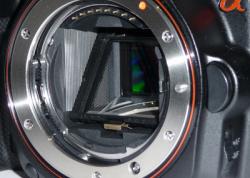Underwater Video Basics

Shooting underwater video has become increasingly popular in recent years. The combination of video camera improvements, powerful video editing software and easy sharing with friends via social media is fuel for the fire. Housing manufacturers are also keeping video recording ergonomics top of mind in new designs. The result is that many photographers are now shooting video in addition to still photos while diving, while other divers have some cheap options for shooting video on small devices.
Video Cameras
There are many options for divers looking to shoot video underwater. We’ve summarized the options below, but make sure to click the links to more detailed info and reviews on the cameras listed below.
Entry-level Options:
The GoPro HERO5 Black shoots HD video in a very compact unit. It’s GoPro’s top-of-the-line camera, complete with wifi and a touchscreen/monitor. The positives are its small size, excellent image quality and ability to stick anywhere for unique angles (like on a polecam). It even shoots raw image, bursts and interval timer stills. The downsides are the lack of complete customizable settings and the short battery life.
Kraken Sports makes a great mobile phone housing (for several brands/models). You phone records great HD video, so why not take advantage of it! Macro and wide-angle wet lenses are available.
Compact Cameras:
Canon, Panasonic, Sony, Fuji, Olympus and several other manufacturers make compact cameras, most of which can be housed for underwater video use. The Sony RX-100 V sits at the top of this list and shoots 4K at 60fps with full manual control, although the Canon G7 X II is preferred by many shooters for it's similar specs and performance. Both of these cameras have a 1" sensor, resulting in much better video and image quality. The SeaLife DC2000 also has a 20MP 1" sensor and will be a popular entry-level choice.
Sony RX100 IV Review | RX100 III Review | RX-100 II Review | RX-100 Review
Mirrorless Cameras:
Mirrorless cameras are an excellent choice for underwater video, boasting larger image sensors and functionality than compacts and much smaller size than DSLRs. These cameras are great for videographers and photographers who don’t want the expense of a DSLR and prefer a compact rig for traveling.
Image quality in today's mirrorless cameras rivals that of DSLRs, and many video shooters have dropped their video systems and DSLRs in favor of the popular mirrorless cameras for video: Sony a7S II and a7R II, Panasonic GH4 and GH5. Mirrorless cameras also have a large (and growing) selection of high-performance lenses, providing the versatility needed for macro, wide-angle and specialized underwater video shooting. The housing manufacturers make a variety of ports to accommodate most lenses and accessories.
Olympus OM-D E-M1 Mark II Review
Olympus OM-D E-M1 In-Depth Review
DSLR Cameras:
DSLRs have been in a race to improve video functionality and quality since the 5D Mark II was released with HD video in late 2008. The video record button on DSLRs keeps becoming more prominent and ergonomically placed so that photographers can switch between still and video with a flick and tap of the thumb. DSLR underwater housings have made the same improvements.
The best option for DSLR video is the Canon 5D Mark IV, boasting 4K video, fast & reliable dual-pixel autofocus tracking, motion JPG recording, and a wide variety of lenses.
Canon 5D Mark IV Review for Video
Canon 70D Review for Underwater Video
Dedicated Video Cameras:
Dedicated video cameras aren’t as popular as they once were (with non-pros), since new DSLRs offer similar video quality, ability to shoot still images, and use a huge range of lenses, housings & ports. That said, Red Digital Cinema and Blackmagic are the most popular choices for pros demaning 6K video, fast frame rates, uncompressed raw recoding and beyond.
Lighting
As with still photography, lighting is critical in shooting great underwater video. Red filters are available for GoPros, however one or two powerful video lights will produce the best results for any camera shooting video.
Lighting starts with a tray and handles that will help the diver hold the camera steady, while allowing ergonomic movement across the camera housing buttons. Strobe/light arms will hold the lights in the position desired depending on the subject and lighting effect wanted.
Two video lights are ideal, however new photographers can use a single light, especially when shooting macro video. There are a number of choices for video lights, including Kracken Sports, I-Torch, Light & Motion (Sola lights), FIX (Neo lights), and Big Blue..
You can learn more about lights on our focus & video light page or compare a huge selection of video lights at Bluewater Photo.
Underwater Monitors
Monitors are very popular among serious underwater video shooters. There are many benefits to using a monitor, including having a large screen to look at, focus peaking, zebras, raw video output and more. Two popular brands are Small HD and Atomos. Both have several different housing options.
Editing Software for Video
Most new computers come with basic video editing software – iMovie or Windows Movie Maker. These programs are very easy to use (for savvy computer users), allowing editing of clips with transition effects, text, and soundtracks. GoPro Studio is a great (free) solution for editing and sharing underwater video. Serious video editors can then step up to powerful paid programs like Adobe Premier Pro and Final Cut. Pretty cool stuff.
Further Reading


RECOMMENDED ARTICLES
SUPPORT THE UNDERWATER PHOTOGRAPHY GUIDE:
The Best Service & Prices on u/w Photo Gear
 Visit Bluewater Photo & Video for all your underwater photography and video gear. Click, or call the team at (310) 633-5052 for expert advice!
Visit Bluewater Photo & Video for all your underwater photography and video gear. Click, or call the team at (310) 633-5052 for expert advice!
The Best Pricing, Service & Expert Advice to Book your Dive Trips
 Bluewater Travel is your full-service scuba travel agency. Let our expert advisers plan and book your next dive vacation. Run by divers, for divers.
Bluewater Travel is your full-service scuba travel agency. Let our expert advisers plan and book your next dive vacation. Run by divers, for divers.





























